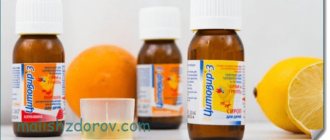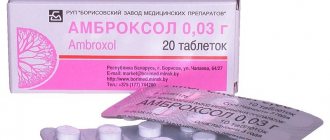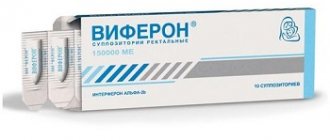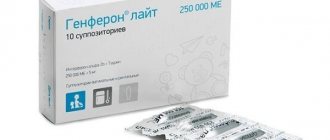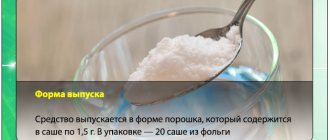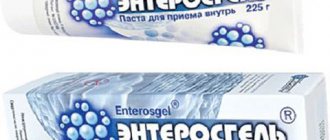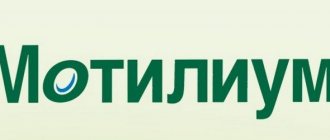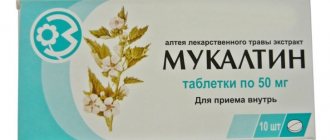Composition of the drug
The drug has the following composition:
- The main active ingredient is hopantenic acid, and 1 ml of syrup contains 100 mg of acid. This substance is a nootropic of natural origin. The medicine is used to treat various mental and neurological diseases.
- Auxiliary components: water, glycerin, citric acid.
- Aspartame and cherry flavoring are added to the medicine - these substances make the syrup sweet and tasty. These components are of natural origin, so they are completely safe for the child’s body.
Indications for use
The syrup treats various neurological and mental disorders in children:
- Brain disorders due to injury and/or infection.
- Cerebral palsy and encephalopathy.
- Urinary disorders of neurogenic origin.
- Various neurological disorders - delayed intellectual development, stuttering, tics, epilepsy, speech problems, memory impairment.
- Mental disorders - decreased performance, hyperactivity, fatigue, headaches, emotional overload.
- Schizophrenia.
Contraindications
Syrup is usually well accepted by the body, but sometimes drinking it is contraindicated:
- Phenylketonuria (the medicine contains aspartame).
- Severe kidney and liver diseases (hopantenic acid is excreted from the body by these organs).
- In case of hypersensitivity to individual components of the drug.
Side effects
The medicine is well tolerated by the body if the dosage is observed. But the following side effects may occur:
- abdominal pain, nausea, sleep problems, loss of appetite and others.
- vomiting, rash, redness of the skin, conjunctivitis, cough, lethargy, increased excitability.
Please note that symptoms appear as an allergic reaction to the constituent components of the drug. If side effects occur, stop taking the medicine and consult a doctor, and if necessary, the doctor changes Pantogam to another medicine.
Pharmaceutical interactions
The active substance Pantogam enhances the effect of anticonvulsants and prolongs the therapeutic effect of barbiturates. When taken in parallel, it neutralizes unwanted reactions from Phenobarbital, Carbamazepine, and antipsychotic drugs.
When used simultaneously, it potentiates the effect of local anesthetics such as novocaine.
The therapeutic effect of the drug is enhanced if it is taken simultaneously with Glycine and etidronic acid.
Directions for use and recommended doses
The syrup is intended for oral administration. The dosage of the drug is determined by the attending physician on an individual basis. Regardless of the dosage, the syrup is taken three times a day for up to six months.
The dosage is prescribed as follows:
| Age | Dosage |
| up to 1 year | 5-10 ml |
| from 1 to 3 years | 6-12 ml |
| from 3 to 7 years | 7-15 ml |
| from 7 to 12 years | 10-20 ml |
| more than 12 years | 15-25 ml |
Pantogam syrup 10% fl. 100ml 61265
Description
Treatment and prevention of brain dysfunctions of various origins in adults and children: cerebrovascular insufficiency caused by atherosclerotic changes in cerebral vessels (as part of complex therapy); initial forms of senile dementia, residual organic brain damage in middle-aged and elderly people (as part of complex therapy); schizophrenia with organic cerebral insufficiency (in combination with antipsychotics, antidepressants); extrapyramidal hyperkinesis in hereditary diseases of the nervous system (including myoclonic epilepsy, Huntington's chorea, hepatocerebral dystrophy, Parkinson's disease); for the correction of the side effects of neuroleptics and at the same time for the purpose of prevention (as “cover therapy”) of chronic extrapyramidal neuroleptic syndrome ( hyperkinetic and akinetic); Epilepsy with slowing of mental processes (in combination with anticonvulsants); consequences of neuroinfections and traumatic brain injuries (as part of complex therapy); psycho-emotional overload, decreased mental and physical performance (to increase concentration and memory); children from the first days of life with perinatal encephalopathy, mental retardation of varying severity, with developmental delays (mental, speech, motor or a combination thereof); various forms of childhood cerebral paralysis; stuttering in children (mainly clonic form); treatment of epilepsy (especially polymorphic seizures), petit mal seizures in children (in combination with anticonvulsants or as monotherapy). Urinary disorders of various etiologies in adults and children over 2 years of age: pollakiuria; imperative urges; urge urinary incontinence; enuresis.
Compound
5 ml of syrup contains pantogam (calcium salt of hopantenic acid) - 500 mg; excipients: glycerol, food grade sorbitol, food grade citric acid, sodium benzoate, aspartame, food grade aromatic essence, purified water.
Application
Take orally 15-30 minutes after meals. Tablets are used in children over 3 years of age; At an earlier age, it is recommended to take the drug in syrup form. For adults, a single dose is 2.5-10 ml (0.25-1 g), a daily dose is 15-30 ml (1.5-3 g). For children, a single dose is 2.5-5 ml (0.25-0.5 g), a daily dose is 7.5-30 ml (0.75-3 g). The course of treatment is 1-4 months, sometimes up to 6 months. After 3-6 months, a second course of treatment is possible. Taking into account the nootropic effect of the drug, it is taken in the morning and afternoon. For schizophrenia (in combination with neuroleptics, antidepressants, tranquilizers), Pantogam is prescribed in a dose of 5 ml to 30 ml (0.5-3 g) per day. The course of treatment is 1-3 months. For epilepsy (in combination with anticonvulsants), the drug is prescribed in a dose of 7.5 ml to 10 ml (0.75-1 g) per day. The course of treatment is up to 1 year or more. For neuroleptic syndrome accompanied by extrapyramidal disorders (in combination with ongoing therapy), the dose of Pantogam is up to 30 ml (3 g) per day. Treatment is carried out over several months. For extrapyramidal hyperkinesis in patients with hereditary diseases of the nervous system (in combination with ongoing therapy), 5 to 30 ml (0.5-3 g) per day are prescribed. The course of treatment is up to 4 months or more. For the consequences of neuroinfections and traumatic brain injuries - 2.5 ml (0.25 g) 3-4 times a day. To restore performance under increased stress and asthenic conditions associated with old age, Pantogam is prescribed 2.5 ml (0.25 g) 3 times a day. For children with various pathologies of the nervous system, depending on age, the following daily doses are recommended: Children under 1 year - 5-10 ml (0.5-1 g); Children 1-3 years old - 15-20 ml (1.5-2 g); Children 3-15 years old - 25-30 ml (2.5-3 g). Tactics for prescribing the drug: increasing the dose over 7-12 days, taking the maximum dose for 15-40 days and gradually reducing the dose over 7-8 days until Pantogam is discontinued. The course of treatment is 30-90 days with a mandatory break of 1-3 months between subsequent doses of both Pantogam and any other nootropic drug. For urinary disorders in adults, the drug is prescribed in a dose of 5-10 ml (0.5-1 g) 2-3 times a day. Children - 2.5-5 ml (0.25-0.5 g), daily dose is 0.025-0.05 g/kg. The course of treatment is 1-3 months.
Possible product names
- Pantogam syrup 10% fl. 100 ml No. 1
- PANTOGAM 10% SYRUP 100 ML
- PANTOGAM 10% 100ML SYRUP
- PANTOGAM SYRUP 10% 100 ML. X1
- PANTOGAM SYRUP 10% 100ML B
- (Pantogam) Pantogam syrup 10% fl. 100 ml No. 1
special instructions
Consider the instructions for taking the syrup:
- The medicine is completely safe for both adults and newborns, and the risk of side effects is minimal if the dosage rules are followed.
- Pantogam has a slight stimulating effect on the body, so the last dose of the medicine is taken 2-3 hours before bedtime.
- It is not recommended to prescribe the drug on your own, since it is quite difficult for a person without special education to determine the optimal dosage of the drug.
Drug overdose
The maximum daily dose is 30 ml of syrup per day. Main symptoms:
- Often - dry mouth, lethargy, drowsiness, cough, nausea.
- Sometimes - pain in the abdominal area, impaired concentration.
- Rarely - liver and kidney dysfunction, vomiting, headache.
Important! In case of overdose, you need to induce vomiting in the child by pressing your fingers on the root of the tongue. Then give the child the sorbent according to the instructions. After this, it is recommended to go to the hospital, and in case of serious violations, call an ambulance.
Undesirable effects and cases of overdose
Despite the fact that in adults taking Pantogam can provoke sleep disturbances, emotional breakdowns, sleepwalking, in children the only adverse reactions observed are allergic processes in the form of conjunctivitis, rhinitis, and skin manifestations. In this case, immediate discontinuation of treatment and prescription of antihistamines is required.
If the dosage of the medication for a child is chosen incorrectly, then unwanted reactions from the brain may occur, such as:
- excitability or vice versa asthenia;
- headache;
- noise in ears;
- dizziness;
- sleep disorders.
If the above described phenomena develop, it is necessary to reduce the dosage of the drug.
In case of a deliberate or accidental overdose of syrup, an increase in negative reactions from the spinal cord and brain (tinnitus, headaches) is observed.
In this case, gastric lavage and the use of adsorbents (Polysorb, Smecta, Neosmectin) are indicated. Treatment is symptomatic; there is no specific antidote.
Analogues of the drug
Pantogam syrup has the following analogues:
- Pantocalcin. A complete analogue is available in tablets and syrup. Indications: neurological disorders, problems with concentration, memory impairment, cerebral palsy. The cost of 1 bottle of pantocalcin is about 600 rubles.
- Cortexin. It is available in the form of an injection solution, and the main active ingredient is the compound of the same name. Therapeutic injections can be given to newborn children. Indications: disruption of the brain and nervous system, apathy, anxiety, unreasonable fear, and so on. The price of 1 ampoule is 700-1000 rubles.
- Piracetam. Release forms: tablets, solution, the active substance is piracetam. The medicine can be given to newborn children; recommendations for use - organic brain damage, mental retardation, depression, mild schizophrenia, hyperactivity syndrome, and so on. The price of 1 blister (10 tablets) is about 100 rubles.
Complex opinion
Reviews from parents and specialists about Pantogam syrup are mostly positive.
The doctor prescribed Pantogam syrup to his son for delayed speech development and febrile convulsions. After treatment, our sleep returned to normal and the child began to talk more.
It is quite problematic to calculate the dose if the child becomes uncontrollable if you overdo it.
Maria
The syrup was prescribed by a neurologist when my daughter turned 2 years old. Diagnosed with delayed speech development. The doctor told me to drink for 30 days, then take a break for the same amount of time.
He warned that we won’t see the effect before 2 months. It's been 4 months and no progress. Didn't help us.
Anastasia
Pantogam should be taken no later than 5 pm, otherwise there will be problems with sleep. For children over 3 years of age, it is better to give the medicine in tablet form. You should not expect a miracle from the drug; on its own it is ineffective; it must be taken in combination with other medications that should be prescribed by a specialist.
Daniya Nailevna neurologist, 35 years of experience
